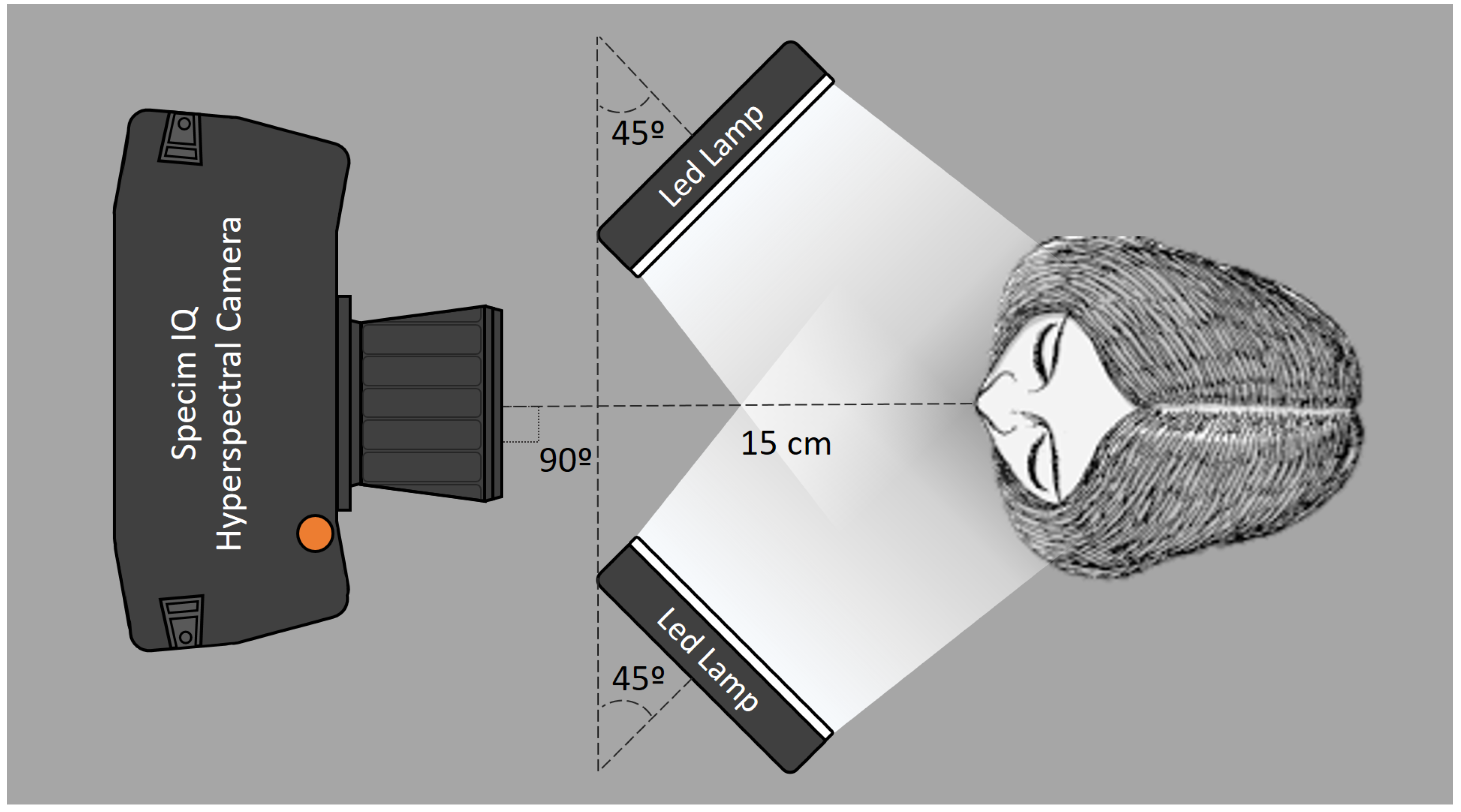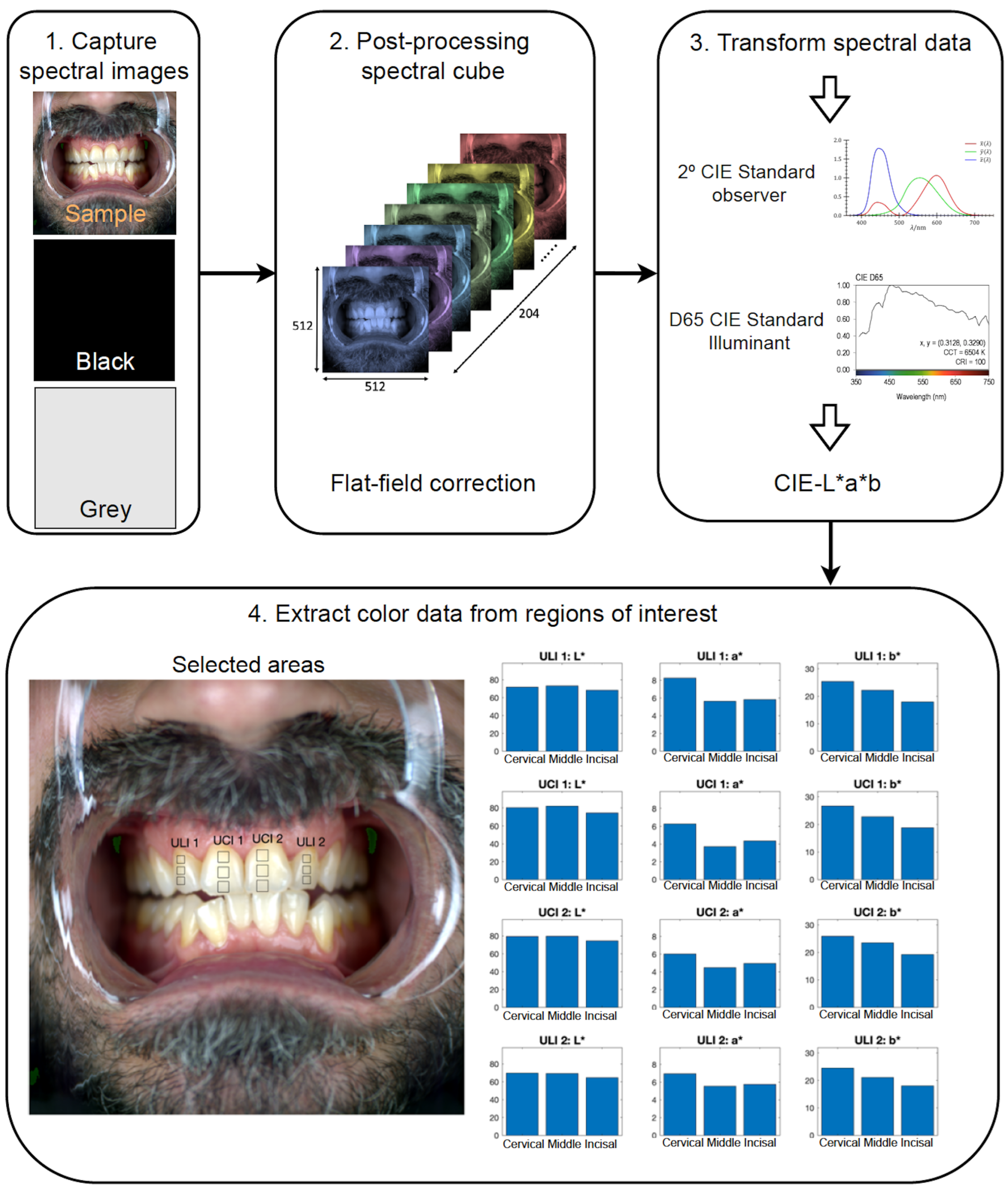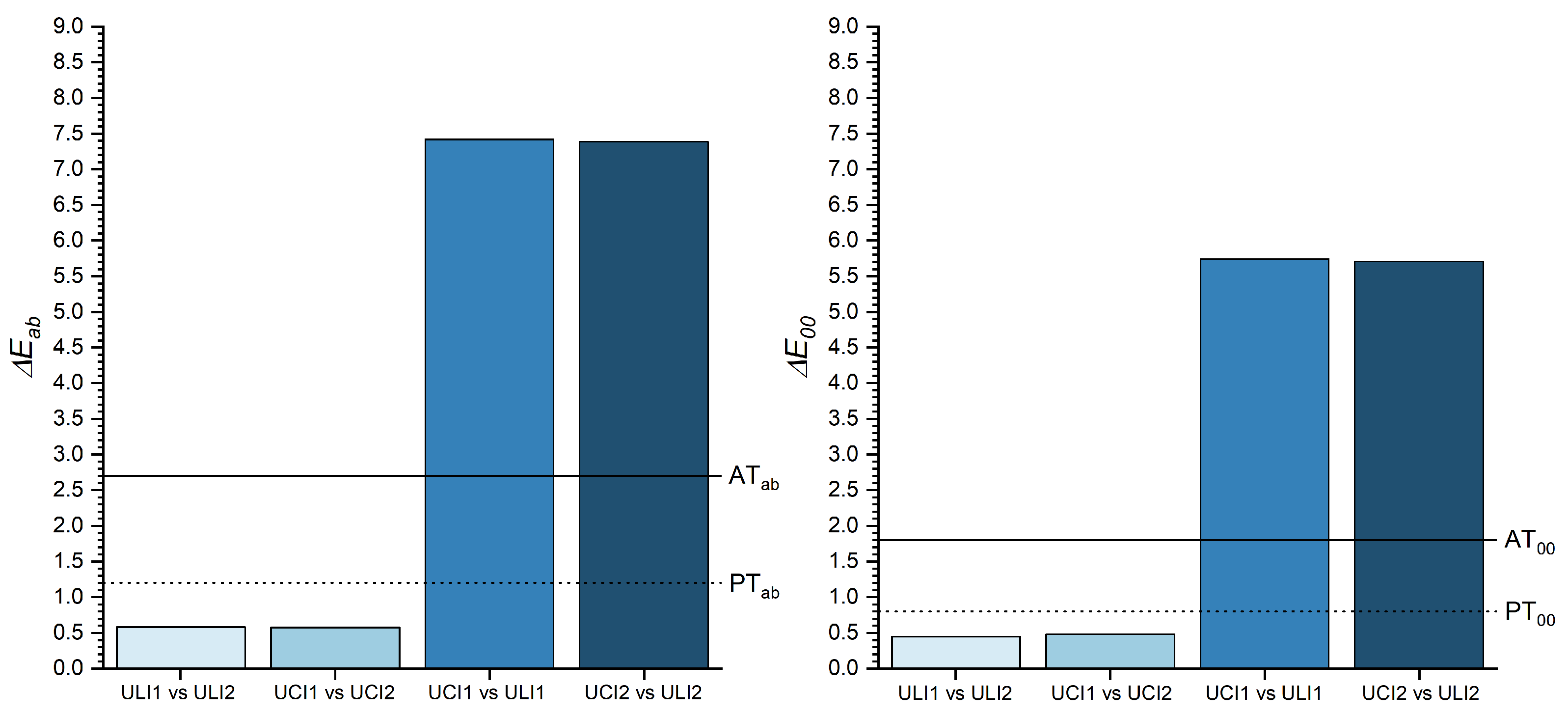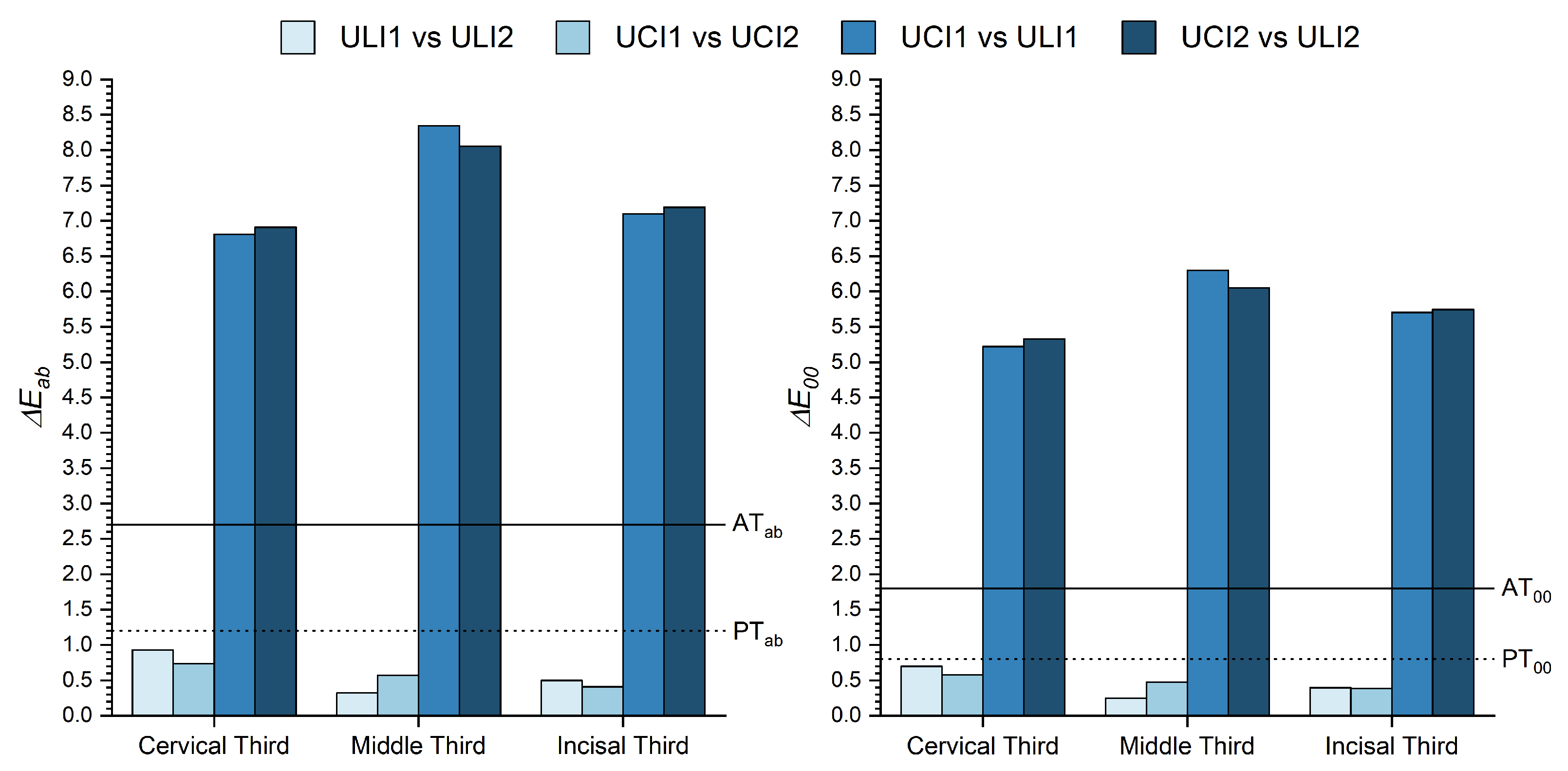Validation of a Hyperspectral Imaging System for Color Measurement of In-Vivo Dental Structures
Abstract
1. Introduction
2. Materials and Methods
2.1. Participants
2.2. Experimental Set-Up
2.3. Data Acquisition and Processing
2.4. Evaluation of Color Differences
3. Results
4. Discussion
5. Conclusions
- The color differences between adjacent teeth exceed the acceptability threshold for adjacent teeth but are lower than the perceptibility threshold between contralateral teeth.
- The color differences between the different parts (thirds) of the same tooth were always higher than the color difference acceptability threshold for dentistry.
Author Contributions
Funding
Institutional Review Board Statement
Informed Consent Statement
Data Availability Statement
Acknowledgments
Conflicts of Interest
References
- Johnston, W.M. Review of translucency determinations and applications to dental materials. J. Esthet. Restor. Dent. 2014, 26, 217–223. [Google Scholar] [CrossRef] [PubMed]
- Shiraishi, T.; Watanabe, I. Thickness dependence of light transmittance, translucency and opalescence of a ceria-stabilized zirconia/alumina nanocomposite for dental applications. Dent. Mater. 2016, 32, 660–667. [Google Scholar] [CrossRef] [PubMed]
- dos Santos, C.; Rosa, G.O.; Quintino, M.N.; Alves, M.F.R.P.; Ribeiro, S.; Melo-Silva, C.L. Effect of surface finishing and thickness on the translucency of zirconia dental ceramics. Ceram. Int. 2020, 46, 7748–7755. [Google Scholar] [CrossRef]
- Angerame, D.; Fanfoni, L.; De Biasi, M.; Bevilacqua, L.; Generali, L. Influence of Thickness and Shade on the Color of Layered Novel Nanohybrid Composite Systems. Int. J. Periodont. Rest. 2021, 41. [Google Scholar] [CrossRef] [PubMed]
- Corciolani, G.; Vichi, A.; Louca, C.; Ferrari, M. Influence of layering thickness on the color parameters of a ceramic system. Dent. Mater. 2010, 26, 737–742. [Google Scholar] [CrossRef]
- Manauta, J.; Salat, A.; Putignano, A.; Devoto, W.; Paolone, G.; Hardan, L. Stratification in anterior teeth using one dentine shade and a predefined thickness of enamel: A new concept in composite layering—Part I. Trop. Dent. J. 2014, 37, 1–9. [Google Scholar]
- Vichi, A.; Fraioli, A.; Davidson, C.L.; Ferrari, M. Influence of thickness on color in multi-layering technique. Dent. Mater. 2007, 23, 1584–1589. [Google Scholar] [CrossRef]
- Đozić, A.; Kleverlaan, C.J.; Aartman, I.H.; Feilzer, A.J. Relation in color among maxillary incisors and canines. Dent. Mater. 2005, 21, 187–191. [Google Scholar] [CrossRef]
- Nalbant, D.; Göknur, B.Y.; Türkcan, İ.; Yerliyurt, K.; Akçaboy, C.; Nalbant, L. Examination of natural tooth color distribution using visual and instrumental shade selection methods. Balkan J. Dent. Med. 2016, 20, 104–110. [Google Scholar] [CrossRef]
- Chu, S.J.; Trushkowsky, R.D.; Paravina, R.D. Dental color matching instruments and systems. Review of clinical and research aspects. J. Dent. 2010, 38, e2–e16. [Google Scholar] [CrossRef]
- Ishikawa-Nagai, S.; Yoshida, A.; Da Silva, J.D.; Miller, L. Spectrophotometric analysis of tooth color reproduction on anterior all-ceramic crowns: Part 1: Analysis and interpretation of tooth color. J. Esthet. Restor. Dent. 2010, 22, 42–52. [Google Scholar] [CrossRef]
- Della Bona, A. Color and Appearance in Dentistry; Springer: Berlin/Heidelberg, Germany, 2020. [Google Scholar]
- Tabatabaian, F.; Beyabanaki, E.; Alirezaei, P.; Epakchi, S. Visual and digital tooth shade selection methods, related effective factors and conditions, and their accuracy and precision: A literature review. J. Esthet Restor. Dent. 2021, 33, 1084–1104. [Google Scholar] [CrossRef] [PubMed]
- Wee, A.G.; Lindsey, D.T.; Kuo, S.; Johnston, W.M. Color accuracy of commercial digital cameras for use in dentistry. Dent. Mater. 2006, 22, 553–559. [Google Scholar] [CrossRef] [PubMed]
- Caglar, A.; Yamanel, K.; Gulsahi, K.; Bagis, B.; Özcan, M. Could digital imaging be an alternative for digital colorimeters? Clin. Oral Investig. 2010, 14, 713–718. [Google Scholar] [CrossRef] [PubMed]
- Garcia, P.; Costa, R.; Calgaro, M.; Ritter, A.; Correr, G.; Cunha, L.; Gonzaga, C. Digital smile design and mock-up technique for esthetic treatment planning with porcelain laminate veneers. J. Conserv. Dent. 2018, 21, 455–458. [Google Scholar] [CrossRef] [PubMed]
- Carrillo-Perez, F.; Pecho, O.E.; Morales, J.C.; Paravina, R.D.; Della Bona, A.; Ghinea, R.; Pulgar, R.; Pérez, M.d.M.; Herrera, L.J. Applications of artificial intelligence in dentistry: A comprehensive review. J. Esthet. Restor. Dent. 2022, 34, 259–280. [Google Scholar] [CrossRef]
- Blaes, J. Today’s technology improves the shade-matching problems of yesterday. J. (Indiana Dent. Assoc.) 2002, 81, 17–19. [Google Scholar]
- Akl, M.A.; Sim, C.P.C.; Nunn, M.E.; Zeng, L.L.; Hamza, T.A.; Wee, A.G. Validation of two clinical color measuring instruments for use in dental research. J. Dent. 2022, 125, 104223. [Google Scholar] [CrossRef]
- Ruiz-López, J.; Espinar, C.; Lucena, C.; de la Cruz Cardona, J.; Pulgar, R.; Pérez, M.M. Effect of thickness on color and translucency of a multi-color polymer-infiltrated ceramic-network material. J. Esthet. Restor. Dent. 2022. [CrossRef]
- Pecho, O.E.; Ghinea, R.; Ionescu, A.M.; Cardona, J.C.; Della Bona, A.; Pérez, M.M. Optical behavior of dental zirconia and dentin analyzed by Kubelka-Munk theory. Dent. Mater. 2015, 31, 60–67. [Google Scholar] [CrossRef]
- Paravina, R.D.; Aleksić, A.; Tango, R.N.; García-Beltrán, A.; Johnston, W.M.; Ghinea, R.I. Harmonization of color measurements in dentistry. Measurement 2021, 169, 108504. [Google Scholar] [CrossRef]
- Tejada-Casado, M.; Ghinea, R.; Perez, M.M.; Lübbe, H.; Pop-Ciutrila, I.S.; Ruiz-López, J.; Herrera, L.J. Reflectance and color prediction of dental material monolithic samples with varying thickness. Dent. Mater. 2022, 38, 622–631. [Google Scholar] [CrossRef] [PubMed]
- Tejada-Casado, M.; Ghinea, R.; Pérez, M.; Cardona, J.; Ionescu, A.; Lübbe, H.; Herrera, L. Color prediction of layered dental resin composites with varying thickness. Dent. Mater. 2022, 38, 1261–1270. [Google Scholar] [CrossRef]
- Garini, Y.; Young, I.T.; McNamara, G. Spectral imaging: Principles and applications. Cytom. Part A J. Int. Soc. Anal. Cytol. 2006, 69, 735–747. [Google Scholar] [CrossRef] [PubMed]
- Li, Q.; He, X.; Wang, Y.; Liu, H.; Xu, D.; Guo, F. Review of spectral imaging technology in biomedical engineering: Achievements and challenges. J. Biom. Opt. 2013, 18, 100901. [Google Scholar] [CrossRef] [PubMed]
- Hyttinen, J.; Fält, P.; Jäsberg, H.; Kullaa, A.; Hauta-Kasari, M. Oral and Dental Spectral Image Database—ODSI-DB. Appl. Sci. 2020, 10, 7246. [Google Scholar] [CrossRef]
- Đozic, A.; Kleverlaan, C.J.; Aartman, I.H.; Feilzer, A.J. Relation in color of three regions of vital human incisors. Dent. Mater. 2004, 20, 832–838. [Google Scholar] [CrossRef] [PubMed]
- Ruiz-López, J.; Pulgar, R.; Lucena, C.; Pelaez-Cruz, P.; Cardona, J.C.; Perez, M.M.; Ghinea, R. Impact of short-term dental dehydration on in-vivo dental color and whiteness. J. Dent. 2021, 105, 103560. [Google Scholar] [CrossRef]
- Nascimento, S.M.; Ferreira, F.P.; Foster, D.H. Statistics of spatial cone-excitation ratios in natural scenes. JOSA A 2002, 19, 1484–1490. [Google Scholar] [CrossRef]
- Fairchild, M.D. CIE 015:2018 Colorimetry, 4th Edition. The International Commission on Illumination, Vienna, Austria. Color Res. Appl. 2019, 44, 674–675. [Google Scholar] [CrossRef]
- Paravina, R.D.; Ghinea, R.; Herrera, L.J.; Bona, A.D.; Igiel, C.; Linninger, M.; Sakai, M.; Takahashi, H.; Tashkandi, E.; Mar Perez, M. Color difference thresholds in dentistry. J. Esthet. Restor. Dent. 2015, 27, S1–S9. [Google Scholar] [CrossRef] [PubMed]
- Paravina, R.D.; Pérez, M.M.; Ghinea, R. Acceptability and perceptibility thresholds in dentistry: A comprehensive review of clinical and research applications. J. Esthet. Restor. Dent. 2019, 31, 103–112. [Google Scholar] [CrossRef] [PubMed]
- ISO/TR 28642; Technical Report(E): Dentistry—Guidance on Color Measurements. Standard, International Organization for Standardization: Geneva, Switzerland, 2016.
- Turgut, S.; Kılınç, H.; Eyüpoglu, G.B.; Bağış, B. Color relationships of natural anterior teeth: An in vivo study. Nigerian J. Clin. Pract. 2018, 21, 925–931. [Google Scholar] [CrossRef]
- Pérez, M.M.; Benavides-Reyes, C.; Tejada-Casado, M.; Ruiz-López, J.; Lucena, C. Does Backgrounds Color Influence the Appearance of Gingiva-Colored Resin-Based Composites? Materials 2022, 15, 3712. [Google Scholar] [CrossRef] [PubMed]
- Baltzer, A.; Kaufmann-Jinoian, V. The determination of the tooth colors. Quintessenz Zahntech 2004, 30, 726–740. [Google Scholar]
- Yuan, J.C.C.; Brewer, J.D.; Monaco, E.A., Jr.; Davis, E.L. Defining a natural tooth color space based on a 3-dimensional shade system. J. Prosthet. Dent. 2007, 98, 110–119. [Google Scholar] [CrossRef]
- Kwon, S. CLSTM: Deep feature-based speech emotion recognition using the hierarchical ConvLSTM network. Mathematics 2020, 8, 2133. [Google Scholar]





| ULI1 | UCI1 | UCI2 | ULI2 | |||||||||
|---|---|---|---|---|---|---|---|---|---|---|---|---|
| L* | a* | b* | L* | a* | b* | L* | a* | b* | L* | a* | b* | |
| Cervical | 68.78 (4.58) | 8.60 (1.38) | 19.36 (2.54) | 75.34 (5.30) | 6.84 (1.14) | 18.85 (2.83) | 74.70 (5.30) | 7.08 (1.34) | 18.58 (2.93) | 67.97 (4.90) | 8.61 (1.12) | 18.90 (2.69) |
| Middle | 70.95 (4.89) | 4.79 (1.00) | 16.94 (2.89) | 79.02 (5.67) | 2.82 (0.77) | 16.18 (2.61) | 78.51 (5.58) | 3.08 (0.98) | 16.18 (3.04) | 70.65 (5.29) | 4.71 (1.03) | 16.86 (2.63) |
| Incisal | 67.01 (4.65) | 4.51 (1.07) | 12.53 (2.66) | 73.70 (4.64) | 2.99 (1.07) | 14.35 (2.75) | 73.39 (5.08) | 3.25 (1.16) | 14.42 (2.90) | 66.54 (5.48) | 4.59 (1.47) | 12.68 (2.68) |
| Study | Color Measurement System | Sample Size | L* | a* | b* |
|---|---|---|---|---|---|
| Djozic et al. [28] | Digital photography | 50 | 73.8 (5.7) | −1.3 (1.4) | 15.9 (2.8) |
| Djozic et al. [8] | Digital photography | 100 | 83 (*) | −6.00 (*) | 18.00 (*) |
| Turgut et al. [35] | Colorimeter | 640 | 80.5 (5.1) | −0.2 (0.4) | 17.1 (3.1) |
| Current | Hypespectral Imaging | 60 | 78.76 (5.62) | 2.95 (0.87) | 16.18 (2.83) |
Publisher’s Note: MDPI stays neutral with regard to jurisdictional claims in published maps and institutional affiliations. |
© 2022 by the authors. Licensee MDPI, Basel, Switzerland. This article is an open access article distributed under the terms and conditions of the Creative Commons Attribution (CC BY) license (https://creativecommons.org/licenses/by/4.0/).
Share and Cite
Tejada-Casado, M.; Ghinea, R.; Martínez-Domingo, M.Á.; Pérez, M.M.; Cardona, J.C.; Ruiz-López, J.; Herrera, L.J. Validation of a Hyperspectral Imaging System for Color Measurement of In-Vivo Dental Structures. Micromachines 2022, 13, 1929. https://doi.org/10.3390/mi13111929
Tejada-Casado M, Ghinea R, Martínez-Domingo MÁ, Pérez MM, Cardona JC, Ruiz-López J, Herrera LJ. Validation of a Hyperspectral Imaging System for Color Measurement of In-Vivo Dental Structures. Micromachines. 2022; 13(11):1929. https://doi.org/10.3390/mi13111929
Chicago/Turabian StyleTejada-Casado, Maria, Razvan Ghinea, Miguel Ángel Martínez-Domingo, María M. Pérez, Juan C. Cardona, Javier Ruiz-López, and Luis Javier Herrera. 2022. "Validation of a Hyperspectral Imaging System for Color Measurement of In-Vivo Dental Structures" Micromachines 13, no. 11: 1929. https://doi.org/10.3390/mi13111929
APA StyleTejada-Casado, M., Ghinea, R., Martínez-Domingo, M. Á., Pérez, M. M., Cardona, J. C., Ruiz-López, J., & Herrera, L. J. (2022). Validation of a Hyperspectral Imaging System for Color Measurement of In-Vivo Dental Structures. Micromachines, 13(11), 1929. https://doi.org/10.3390/mi13111929









